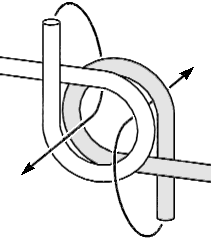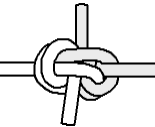| Zeppelin Bend |
| Also
known as the Rosendahl Bend, it's perhaps the best way to connect two
ropes that there is. It's exceptionally secure and shake-resistant in
all materials and its perfect symmetry makes it simple to check. It's also remarkably easy to
untie after heavy strain, even when wet. If you're trying to learn it, think "b" and "q" with reference to the starting shapes of the ropes. Although the Zeppelin Bend can join ropes of different sizes and materials, no bend works properly when joining ropes of vastly different diameters. You'll often notice this when the bend doesn't draw up neatly. In such cases, you should consider joining the ropes with a hitch like the Sailor's Hitch, treating the larger rope as a passive object, or just use interlocking loops. Note: The Zeppelin Bend is not the Rigger's Bend/Hunter's Bend (which jams)! They only look similar.
An article by Lee and Bob Payne called “The Forgotten Zeppelin Knot” in Boating Magazine (March 1976) revealed how this knot was used until 1962 by the US Navy to tether its lighter-than-air ships. Able seaman Joe Collins, a marlinespike seamanship instructor in the 1930s, told the Paynes that he had served under the American aeronaut hero Lieutenant Commander Charles Rosendahl, skipper of the dirigible Los Angeles, and: “There was only one knot he allowed... either for bending lines together on the airship or for use on the mooring lines. I called it the Rosendahl bend.” -Excerpt from The Complete Book of Sailing Knots Related page: Zeppelin Loop (Rosendahl Loop) |
 |
 |
